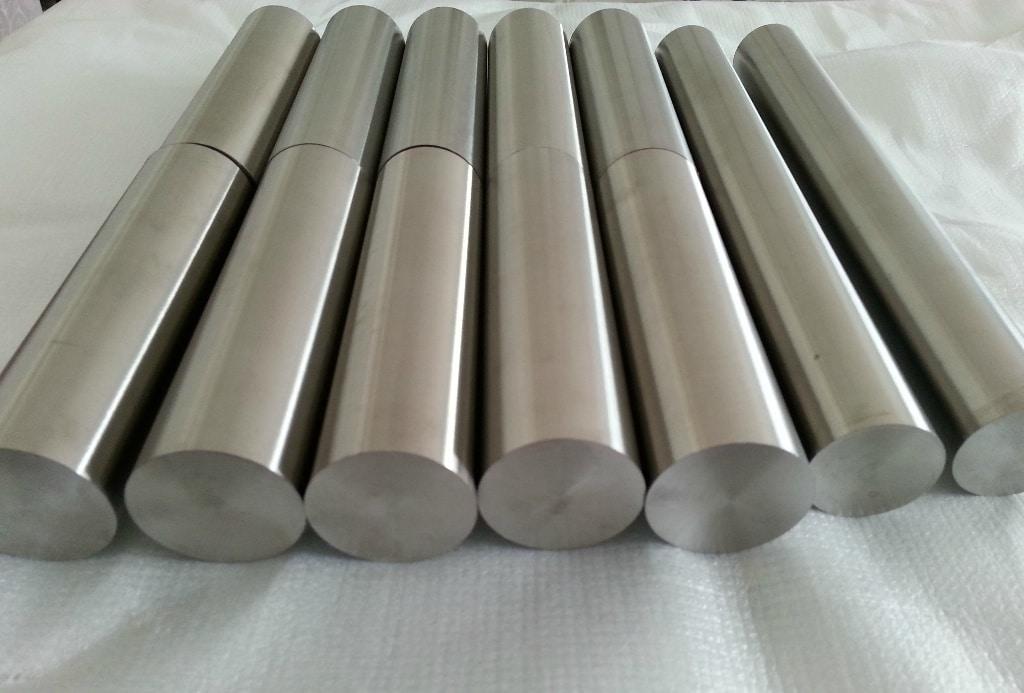First. Analysis of common faults In production, it is found that the common faults of titanium alloy machining surface quality include over-corrosion, ash hanging, incomplete removal of oxide scale and striped mottled.
1. Over-corrosion Over-corrosion refers to the appearance of pits or uneven defects on the surface of titanium alloys after pickling, which is different from the material structure. Generally, the cause of over-corrosion defects is the imbalance of the ratio of hydrofluoric acid and nitric acid. The defect can occur if the concentration of hydrofluoric acid is too high or the concentration of nitric acid is insufficient. Another reason is that the pickling time is too long. Generally, pickling t is 1min. ~4min, the process parameters can be adjusted according to the operation site, and the pickling time can be shortened appropriately.
2. Hanging ash Hanging ash refers to the oxides attached to the surface of the titanium alloy after pickling. During the pickling process, due to the chemical reaction between the titanium alloy and the acid solution, the generated oxides accumulate on the surface, preventing the further occurrence of the reaction. The defects of hanging ash are generally caused by excessive deposition of ash during pickling and insufficient flushing after pickling. During pickling, the parts should be continuously shaken to make the reacted products fall off the surface of the titanium alloy. After pickling, spraying or washing should be strengthened to remove the ash. In China, high-speed water flow mixed with compressed air and tap water is generally used to wash parts, and the effect is good.
3. There are many reasons for the defect that the oxide scale is not removed completely, and each process is possible. It is possible that the oil removal is not good, or the molten salt treatment time is not enough, or the pickling solution is invalid. When this defect occurs, various possible factors should be excluded one by one, and if necessary, sandblasting process can be added to the pretreatment.
4. The cause of this defect is generally caused by uneven reaction. This can be eliminated by shaking the parts during pickling and lowering the temperature of the pickling solution. In addition to the above-mentioned defects, it is sometimes found that the products that have passed the inspection after pickling, after a period of time, appear mottled on the surface. For this phenomenon, there are relatively few studies now, which may be due to the presence of residual acid on the surface after pickling or the presence of corrosive media brought in by subsequent production, which is produced under the combined action of stress, and is different from general corrosion morphology under microscopic inspection. The difference, generally speaking, does not affect its performance, and can be removed by pickling again, but the stress-bearing parts should strengthen the hydrogen removal treatment after the second pickling.
Second. Factors affecting the machinability of titanium alloys
Thermal conductivity, elastic modulus, chemical activity, alloy type and microstructure are the main factors affecting the machinability of titanium alloys. The thermal conductivity of titanium alloy is small, about 1/3 of iron, and the heat generated during machining is difficult to release through the workpiece; at the same time, due to the small specific heat of titanium alloy, the local temperature rises rapidly during processing, so it is easy to cause high tool temperature. , so that the tool tip wears sharply and the service life is reduced. Experiments show that the temperature of the front end of the tool cutting titanium alloy is 2 to 3 times higher than that of cutting steel. The low elastic modulus of titanium alloy makes the machined surface easy to spring back, especially the machining springback of thin-walled parts is more serious, which is easy to cause strong friction between the flank and the machined surface, thereby wearing the tool and chipping. Titanium alloy has strong chemical activity, and it is easy to interact with oxygen, hydrogen and nitrogen at high temperature, which increases its hardness and reduces its plasticity. It is difficult to machine the oxygen-rich layer formed during heating and forging. Titanium alloys have different alloy compositions and different processing properties. In the annealed state, α-type titanium alloys have better machinability; α+β-type titanium alloys are second; β-type titanium alloys have high strength and good hardenability. But the machinability is the worst. In view of the above situation, in order to carry out high-efficiency and high-precision machining of titanium alloys, corresponding measures should be taken to avoid the occurrence of defects in processing.
Third. Research on various mechanical processing of titanium alloys
There are many methods of machining titanium alloys, including: turning, milling, boring, drilling, grinding, tapping, sawing, EDM, etc.
1. Turning and boring of titanium alloys The main problems of turning titanium alloys are: high cutting temperature; serious tool wear; large cutting rebound. Turning and boring are not particularly difficult operations under the right machining conditions. For continuous cutting, mass production or cutting with a large amount of metal removal, carbide tools are generally used; when forming cutting, grooving or cutting, adjusting steel tools are suitable, and cermet tools are also used. As with other machining operations, a constant forced feed is always used to avoid cutting interruptions. Do not stop or slow down during cutting. Generally, do not cut, but should be fully cooled; the coolant can be 5% sodium nitrate aqueous solution or 1/20 soluble oil emulsion aqueous solution. Before forging, the oxygen-enriched layer on the surface of the original bar is turned with a cemented carbide tool, the cutting depth should be greater than the thickness of the oxygen-enriched layer, the cutting speed is 20-30m/min, and the feed rate is 0.1-0.2mm/r. Boring is finishing, especially for thin-walled titanium alloy products, in the boring process, burns and parts clamping deformation should be prevented.
2. Drilling of titanium alloys When drilling titanium alloys, it is easy to generate long and thin curled chips, and at the same time, the drilling heat is large, which is easy to cause excessive accumulation of chips or adhere to the drilling edge, which makes it difficult to drill titanium alloys. main reason. Drilling should be done with a short and sharp drill bit and forced feed at low speed, the support bracket should be tightened, and repeated sufficient cooling should be given, especially for deep hole drilling. During the drilling process, the drill bit should keep the drilling state in the hole and not allow idling in the hole, and should maintain a low and constant drilling speed [3]. Drill through holes carefully. When you are about to drill through, in order to clean the drill bit and drill holes and remove drilling chips, it is best to return the drill bit. When the hole is finally broken, use forced feed, so that a smooth hole can be obtained.
3. Tapping of titanium alloys Tapping of titanium alloys may be the most difficult machining process. When tapping, the limited removal of titanium chips and a severe tendency to bite will result in poor thread fit, resulting in taps jamming or breaking. Titanium alloys tend to tighten on the tap when tapping is complete. Therefore, blind holes or excessively long through holes should be avoided as much as possible to prevent the surface roughness of the internal thread from becoming larger or the phenomenon of taper breaking. At the same time, it is necessary to continuously improve the tapping method, such as grinding off the trailing edge of the tap, grinding the axial chip groove on the tooth top along the length of the tooth blade, etc. On the other hand, taps whose surfaces are oxidized, oxidized or chrome-plated are used to reduce seizure and wear.
4. Sawing of titanium alloys When sawing titanium alloys, low surface speed and continuous forced feeding should be used. Experiments show that the coarse-toothed high-speed steel saw blade with a tooth pitch of 4.2 mm to 8.5 mm is suitable for sawing titanium alloys. If a band saw is used to saw titanium alloys, the tooth pitch of the saw blade is determined by the thickness of the workpiece, generally 2.5mm to 25.4mm. The thicker the material thickness, the larger the tooth pitch. At the same time the forced feed capacity and the required coolant must be maintained.
5. EDM of titanium alloy EDM of titanium alloy requires an operating gap between the tool and the workpiece. The best clearance range is 0.005mm to 0.4mm. Smaller clearances are often used for finishing where smooth surfaces are required, and larger clearances are used for roughing where metal is required to be removed quickly. The electrode materials are preferably copper and zinc. Through the above analysis and research, the failure causes of the surface quality of titanium alloy machining are obtained, and various methods in the machining process are analyzed, so as to find a practical solution to the problem of titanium alloy machining surface quality.

